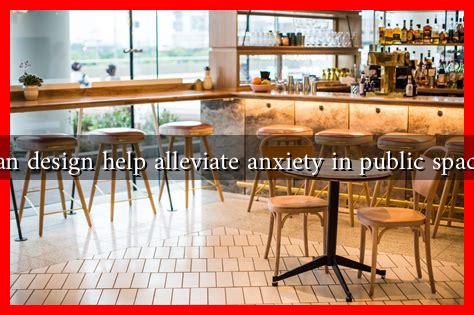-
Table of Contents
- Can Design Help Alleviate Anxiety in Public Spaces?
- The Impact of Public Space Design on Mental Health
- Case Studies: Successful Design Interventions
- 1. The High Line, New York City
- 2. The Oslo Opera House, Norway
- 3. The Eden Project, Cornwall, UK
- Design Elements That Alleviate Anxiety
- The Role of Community Engagement in Design
- Conclusion: The Future of Public Space Design
Can Design Help Alleviate Anxiety in Public Spaces?
In an increasingly urbanized world, public spaces are essential for social interaction, recreation, and community engagement. However, these spaces can also be sources of anxiety for many individuals. The design of public areas plays a crucial role in shaping our experiences and emotions. This article explores how thoughtful design can alleviate anxiety in public spaces, supported by research, case studies, and practical examples.
The Impact of Public Space Design on Mental Health
Public spaces, such as parks, plazas, and transit stations, are often bustling with activity. While they can foster community and connection, they can also induce feelings of stress and anxiety. According to a study published in the journal *Environment and Behavior*, the design of public spaces significantly influences users’ mental well-being. Key factors include:
- Accessibility: Spaces that are easy to navigate reduce feelings of overwhelm.
- Natural Elements: Incorporating greenery and water features can lower stress levels.
- Social Interaction: Designs that encourage social engagement can enhance feelings of safety and belonging.
Case Studies: Successful Design Interventions
Several cities around the world have implemented design strategies aimed at reducing anxiety in public spaces. Here are a few notable examples:
1. The High Line, New York City
The High Line is an elevated linear park built on a former railway line. Its design incorporates natural landscaping, art installations, and seating areas that encourage relaxation and social interaction. A study by the *Project for Public Spaces* found that visitors reported lower stress levels and increased feelings of happiness while using the park.
2. The Oslo Opera House, Norway
The Oslo Opera House features a unique design that invites the public to walk on its sloping roof, providing panoramic views of the city and waterfront. This open-access design fosters a sense of community and encourages people to engage with the space, reducing feelings of isolation and anxiety.
3. The Eden Project, Cornwall, UK
The Eden Project is an ecological park that combines stunning architecture with lush gardens. The biomes create a microclimate that promotes biodiversity and offers visitors a tranquil escape from urban life. Research indicates that spending time in such environments can significantly reduce anxiety and improve overall mental health.
Design Elements That Alleviate Anxiety
To create public spaces that promote mental well-being, designers can incorporate several key elements:
- Natural Light: Maximizing natural light can enhance mood and reduce feelings of anxiety.
- Comfortable Seating: Providing ample seating options encourages people to linger and socialize.
- Clear Signage: Well-placed signs can help individuals navigate spaces with ease, reducing stress.
- Quiet Zones: Designating areas for quiet reflection can provide a necessary respite from the hustle and bustle.
The Role of Community Engagement in Design
Involving the community in the design process is crucial for creating spaces that meet the needs of users. Engaging local residents can provide valuable insights into their experiences and preferences. For instance, participatory design workshops can help identify specific anxiety triggers in public spaces and generate ideas for improvement.
Moreover, cities like Barcelona have adopted a “superblock” model, which prioritizes pedestrian-friendly areas and reduces traffic congestion. This approach not only enhances the quality of public spaces but also fosters community interaction, ultimately reducing anxiety levels among residents.
Conclusion: The Future of Public Space Design
As urban areas continue to grow, the importance of designing public spaces that alleviate anxiety cannot be overstated. By incorporating natural elements, promoting accessibility, and engaging communities in the design process, we can create environments that foster well-being and connection. The examples and strategies discussed in this article highlight the potential of design to transform public spaces into havens of tranquility amidst the chaos of urban life.
In summary, thoughtful design can significantly impact mental health in public spaces. By prioritizing user experience and well-being, we can create environments that not only serve functional purposes but also nurture the emotional health of individuals and communities alike.
For further reading on the impact of design on mental health, visit Psychology Today.

